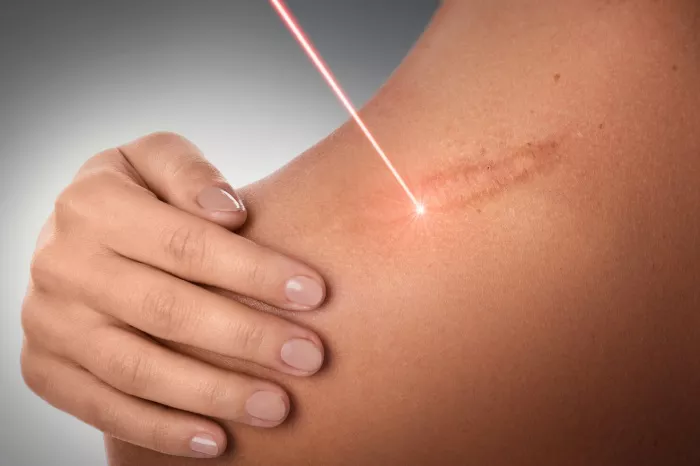Scars are not just physical reminders of past injuries or surgeries; they can also significantly impact an individual’s emotional and psychological well-being. Fortunately, advancements in dermatological technology have provided us with laser treatments that can effectively improve the appearance of scars. This comprehensive guide will explore the various types of laser treatments available for scar revision, their benefits, potential risks, and other vital considerations.
Laser Scar Revision
Laser scar revision is a cutting-edge aesthetic procedure that uses focused light therapy to improve the texture, color, and overall appearance of scars. This treatment works by either removing the outer layer of the skin or by stimulating the production of new collagen and skin cells beneath the scar’s surface. By doing so, laser treatments can make the scars less noticeable and more consistent with the surrounding skin.
Types of Lasers Used for Scar Revision
The choice of laser is crucial in determining the effectiveness of scar treatment. Each type of laser has specific characteristics that make it suitable for treating different kinds of scars, including their depth, texture, and color.
Ablative Lasers
Ablative lasers, such as the CO2 laser and the Erbium:YAG laser, are among the most commonly used for scar revision. These lasers work by vaporizing the top layers of damaged skin at controlled levels of penetration.
CO2 Lasers: The carbon dioxide (CO2) laser is a powerful ablative laser often used for deeper scars, including those from surgeries or injuries. It removes the damaged outer layer of the skin while simultaneously heating the underlying skin. This process encourages the production of collagen, which helps in reducing the depth of depressions and improves the texture of the skin.
Erbium Lasers: Erbium lasers are less intense compared to CO2 lasers and are therefore used for milder or superficial scars. They offer a shorter recovery time but may require multiple sessions to achieve optimal results.
Non-Ablative Lasers
Non-ablative lasers do not remove any skin layers; instead, they heat the skin beneath the scar to encourage collagen growth and new skin cell production.
Fraxel Lasers: Fraxel is a brand that primarily uses non-ablative lasers to treat minor to moderate skin damage. It is particularly effective for treating superficial scars and can improve skin texture and pigmentation without significant downtime.
Pulsed Dye Laser (PDL): PDL treatments are known for their effectiveness in improving the color of scars, especially redness. They work by targeting blood vessels beneath the scar tissue, thereby reducing redness and improving the scar’s color to blend more naturally with the surrounding skin.
Other Laser Types
Picosecond Lasers: These lasers deliver energy in ultra-short bursts. One of the notable advantages of picosecond lasers is their ability to break down scar tissue for natural regeneration without extensive thermal damage to surrounding tissues.
Fractional Lasers: Fractional lasers can be ablative or non-ablative and work by targeting a fraction of the skin at a time. This method allows for intense treatment of the scar while leaving surrounding areas intact to aid in the healing process.
Factors Influencing Laser Choice
Choosing the right type of laser for scar revision is influenced by several factors:
Scar Type: The nature of the scar (e.g., keloidal, hypertrophic, atrophic) significantly impacts the choice of laser.
Skin Type: Different skin types react differently to laser treatment. For example, darker skin tones are more susceptible to changes in pigmentation.
Individual Goals: Expectations and desired outcomes also play a crucial role in selecting the appropriate laser treatment.
Benefits of Laser Scar Revision
Laser treatments can significantly enhance the appearance of scars by:
Improving Texture: Making the surface of the scar smoother.
Color Correction: Helping the scar blend more with the natural skin tone.
Reduced Visibility: Making the scar less noticeable.
Risks and Side Effects
While laser treatments are generally safe, they do carry some risks, which may include:
Redness and Swelling: Common immediate side effects that typically subside within a few days.
Hyperpigmentation: This is a potential risk, especially for individuals with darker skin tones.
Infection and Scarring: Although rare, improper post-treatment care can lead to infections or additional scarring.
The Importance of a Personalized Consultation
Due to the complex nature of scars and skin, a personalized consultation with a qualified dermatologist or cosmetic surgeon is essential. This assessment will help determine the most effective laser treatment plan tailored to an individual’s specific needs and skin type.
Alternatives to Laser Scar Revision
In some cases, individuals may opt for alternative scar treatment methods, which can include:
Topical Creams: These can be used for very superficial scars.
Injections: Steroid injections are sometimes used to treat keloids or hypertrophic scars.
Surgical Revision: In more severe cases, surgical removal of the scar might be considered.
Conclusion
Laser scar revision represents a forefront in dermatological treatments, offering hope and improved aesthetics to those suffering from scarring. It’s crucial, however, to approach this treatment with realistic expectations and under the guidance of experienced professionals. With the right approach and technology, laser scar revision can significantly improve the appearance of scars, thus enhancing both physical and psychological well-being.
[inline_related_posts title=”You Might Be Interested In” title_align=”left” style=”list” number=”6″ align=”none” ids=”7805,7673,7737″ by=”categories” orderby=”rand” order=”DESC” hide_thumb=”no” thumb_right=”no” views=”no” date=”yes” grid_columns=”2″ post_type=”” tax=””]
































